L'Ecole, School of Jewellery Arts, which is supported by French maison Van Cleef & Arpels has set up a temporary workshop and exhibition arena at Hai D3 in Dubai, until November 25. Wearing Jewellery: Rules and Revolutions is one of the talks that will be conducted at the venue on November 21 at 2.30pm.
Part of L’Ecole’s Art History of Jewellery series of workshops, the Rules and Revolutions talk is centred on one multifaceted question: why do we wear jewellery? The interactive session goes on to provide a treasure trove of insights into humankind’s history, psyche and social evolution, all vis-à-vis jewellery-wearing traditions and preferences.
There’s not one way to tell this tale, which embodies shifting narratives of valour and vanity, status and identity, and health and happiness. Much of it is anecdotal, almost all of it sentimental. Conducted by the enthusiastic Inezita Eckel, an art historian and professor at L’Ecole, the talk draws parallels between famed historical figures separated by cultures and continents, as well as between the rules formulated by fashion influencers of the past and modern-day norm-breakers. For instance, Eckel points out that the “ornaments” of the head of the Zulu tribe in Africa – various beads and amulets, and a coat made from animal skins – were no less precious than the French “Sun King” Louis XIV’s jewel-encrusted sword, crown and fur coat.
Some traditions may disappear after one generation, such as Berber jewellery, while others get absorbed and reinterpreted. “The chatelaine clasp, worn by the mistress of the chateau in 19th-century Europe, started off as an ornament to hang the keys to the armoury, so that the men would not have free access to the weapons and kill each other. Soon after, though, the chatelaine became like the Hermès Birkin of the time, with women customising it to attach all manner of things, including sewing equipment,” says Eckel.
In another time and place, the royal concubine Theodora was loaded with jewels to show her elevated status, while Queen Elizabeth I took to wearing “buckets of pearls” to prove her femininity. The Victorian era gave us the concept of funeral or mourning jewellery, while female horse riders in China focused on elaborate hair jewellery. Over in India, the Mughal kings favoured spinels, which protected them from excessive blood loss during war, while the rulers of the princely states – notably the ruler of Patiala – wore their weight in gold and gems. One thing was clear: in the past, displaying as much jewellery as you could was almost a given in many, if not all, cultures.
By the 1920s, however, fashion doyenne Gabrielle “Coco” Chanel promoted the ideas of minimalism and subtlety, when she declared that jewellery should be easy to put on and take off. Cut to Karl Lagerfeld – the indomitable master of the house that Chanel founded – who is known for his penchant for fingers-full of armour-like rings. The rules, then, are constantly shifting and blurring. “Have you ever heard the good news, bad news jokes?” asks Eckel. “When it comes to wearing jewellery, what has happened to the rules? Good news, the rules are likely gone. Bad news, there is no structure left. Good news, you can make your own.”
Fascinating stories and fabulous jewellery aside, the session also includes a fun true or false round, where participants debate on topics such as whether or not engagement rings can be worn on the right hand; should ears be pierced before the age of 1; and if the opal gemstone truly brings bad luck. The talk aims to spark a dialogue among groups of people who come from different backgrounds, and get them talking and sharing and arguing. Eckel says participants end up discovering so much more in the process – about each other as well as the world of gems and jewels.
Wearing Jewellery: Rules and Revolutions will take place on November 21 from 2.30pm to 4.30pm at L’Ecole in Hai D3, Dubai. A minimum donation of Dh400 is expected, an amount that goes entirely to Dubai Cares. To register, call 04 425 2740, email lecole_me@vancleefarpels.com or visit me.lecolevancleefarpels.com
_______________
Read more:
A behind-the-scenes look at the making of high jewellery
A peek inside the alluring world of secret jewellery and hidden watches
Secret jewels for your collection – in pictures
_______________


